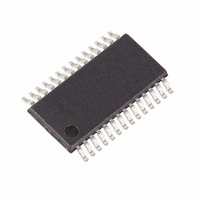DS3882E+C Maxim Integrated Products, DS3882E+C Datasheet - Page 26

DS3882E+C
Manufacturer Part Number
DS3882E+C
Description
IC CCFL CNTRLR DUAL 28TSSOP
Manufacturer
Maxim Integrated Products
Type
CCFL Controllerr
Datasheet
1.DS3882EC.pdf
(31 pages)
Specifications of DS3882E+C
Frequency
40 ~ 100 kHz
Current - Supply
12mA
Voltage - Supply
4.75 V ~ 5.25 V
Operating Temperature
-40°C ~ 105°C
Package / Case
28-TSSOP
Maximum Operating Temperature
+ 105 C
Mounting Style
SMD/SMT
Minimum Operating Temperature
- 40 C
Lead Free Status / RoHS Status
Lead free / RoHS Compliant
Current - Output
-
Lead Free Status / Rohs Status
Lead free / RoHS Compliant
Other names
Q3390330
Dual-Channel Automotive CCFL Controller
The following terminology is commonly used to
describe I
Master Device: The master device controls the slave
devices on the bus. The master device generates SCL
clock pulses, start, and stop conditions.
Slave Devices: Slave devices send and receive data
at the master’s request.
Bus Idle or Not Busy: Time between stop and start
conditions when both SDA and SCL are inactive and in
their logic-high states.
Start Condition: A start condition is generated by the
master to initiate a new data transfer with a slave.
Transitioning SDA from high to low while SCL remains
high generates a start condition. See the timing dia-
gram for applicable timing.
Stop Condition: A stop condition is generated by the
master to end a data transfer with a slave. Transitioning
SDA from low to high while SCL remains high gener-
ates a stop condition. See the timing diagram for
applicable timing.
Repeated Start Condition: The master can use a
repeated start condition at the end of one data transfer
to indicate that it will immediately initiate a new data
transfer following the current one. Repeated starts are
commonly used during read operations to identify a
specific memory address to begin a data transfer. A
repeated start condition is issued identically to a nor-
mal start condition. See the timing diagram for applica-
ble timing.
Figure 9. I
26
SDA
SCL
NOTE: TIMING IS REFERENCE TO V
____________________________________________________________________
STOP
2
C Timing Diagram
2
C data transfers:
t
BUF
START
IL(MAX)
t
t
HD:STA
LOW
AND V
IH(MIN)
.
I
t
2
R
t
HD:DAT
C Definitions
t
F
t
HIGH
t
SU:DAT
Bit Write: Transitions of SDA must occur during the low
state of SCL. The data on SDA must remain valid and
unchanged during the entire high pulse of SCL plus the
setup and hold time requirements (see Figure 9). Data is
shifted into the device during the rising edge of the SCL.
Bit Read: At the end of a write operation, the master
must release the SDA bus line for the proper amount of
setup time (see Figure 9) before the next rising edge of
SCL during a bit read. The device shifts out each bit of
data on SDA at the falling edge of the previous SCL
pulse and the data bit is valid at the rising edge of the
current SCL pulse. Remember that the master gener-
ates all SCL clock pulses including when it is reading
bits from the slave.
Acknowledgement (ACK and NACK): An acknowl-
edgement (ACK) or not acknowledge (NACK) is always
the 9th bit transmitted during a byte transfer. The
device receiving data (the master during a read or the
slave during a write operation) performs an ACK by
transmitting a zero during the 9th bit. A device per-
forms a NACK by transmitting a one during the 9th bit.
Timing (Figure 9) for the ACK and NACK is identical to
all other bit writes. An ACK is the acknowledgment that
the device is properly receiving data. A NACK is used
to terminate a read sequence or as an indication that
the device is not receiving data.
Byte Write: A byte write consists of 8 bits of informa-
tion transferred from the master to the slave (most sig-
nificant bit first) plus a 1-bit acknowledgement from the
slave to the master. The 8 bits transmitted by the mas-
ter are done according to the bit-write definition and the
acknowledgement is read using the bit-read definition.
REPEATED
START
t
SU:STA
t
HD:STA
t
SP
t
SU:STO











